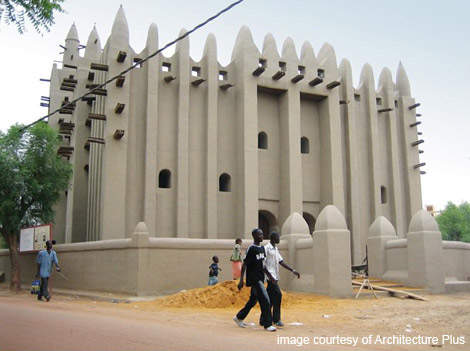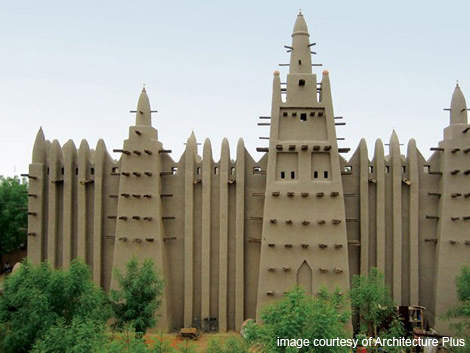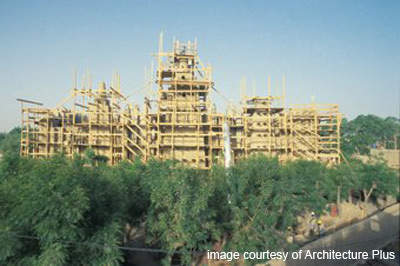The restoration of the Great Mosque of Mopti by the Historic Cities Programme of the Aga Khan Trust for Culture (AKTC) was completed in June 2006. Situated on the banks of the Niger River in Mali, West Africa, the mosque is a remarkable example of the earthen construction typical of this region; a tradition that dates back to the ninth century and the rise of the ancient empires of West Africa.
Located in the Komoguel neighbourhood, the Great Mosque of Mopti (c.1936–c.1943) is a late addition to the region’s architecture and is built on the site of the earlier Friday Mosque (c.1908).
now been
re-established.”
As a result of the scarcity of stone and timber, earth, in the form of sun-dried bricks and plaster is the traditional building material.
The skilful use of this material, called banco coupled with palm for floors and roofs has evolved over time into a distinct architectural language that is best described as a unique blend of indigenous forms and Islamic traditions.
MOSQUE RESCUE MISSION
AKTC’s decision in 2003 to undertake the restoration of the Great Mosque of Mopti focused on a major structural problem caused by the deterioration of a layer of concrete, added to the building in the 70s.
It was also seen as a way to bring to the attention of the local authorities and professional circles the damage caused by well-intended but inappropriate interventions, as well as the urgent need to reintroduce traditional materials and well-tested methods of repair and conservation.
All of the restoration was undertaken in close coordination with the Direction National du Patrimoine Culturel (DNPC) of the Ministry of Culture, the regional authorities, the City of Mopti and the Comité de Gestion de la Grande Mosquée de Mopti.
MOSQUE OF MOPTI RESTORATION
The restoration comprised different phases and activities including: the demolition of the fired brick and cement upper section of the structure and the subsequent reinstatement of the original earthen bricks and plaster; the complete substitution of the structural timber and roof cover, which had been seriously compromised by termite infestation; the repair of the damaged sections of earthen brickwork and pillars along the exterior façades of the buildings; the partial reconstruction of damaged portions of the parapet, pinnacles, towers and minarets; and the application of several coats of banco pourri to the external walls.
The work on the exterior yard focused on establishing effective falls for the rapid draining of rainwater from the site, the reconstruction of the fence wall and the construction new sanitary and ablution facilities. The interior of the mosque was also improved with the substitution of the cement floor, renovation of the interior stair to the terrace, and a complete overhaul of the ventilation, sound and electrical systems. The mosque has also been fitted with new doors, made of local high-quality seasoned wood.
Following the restoration, the original proportions and features of the Great Mosque of Mopti that had been transformed over time, have now been re-established. The restoration team used historical photographs and physical traces found in the building itself to ascertain the scale of the original building elements.






